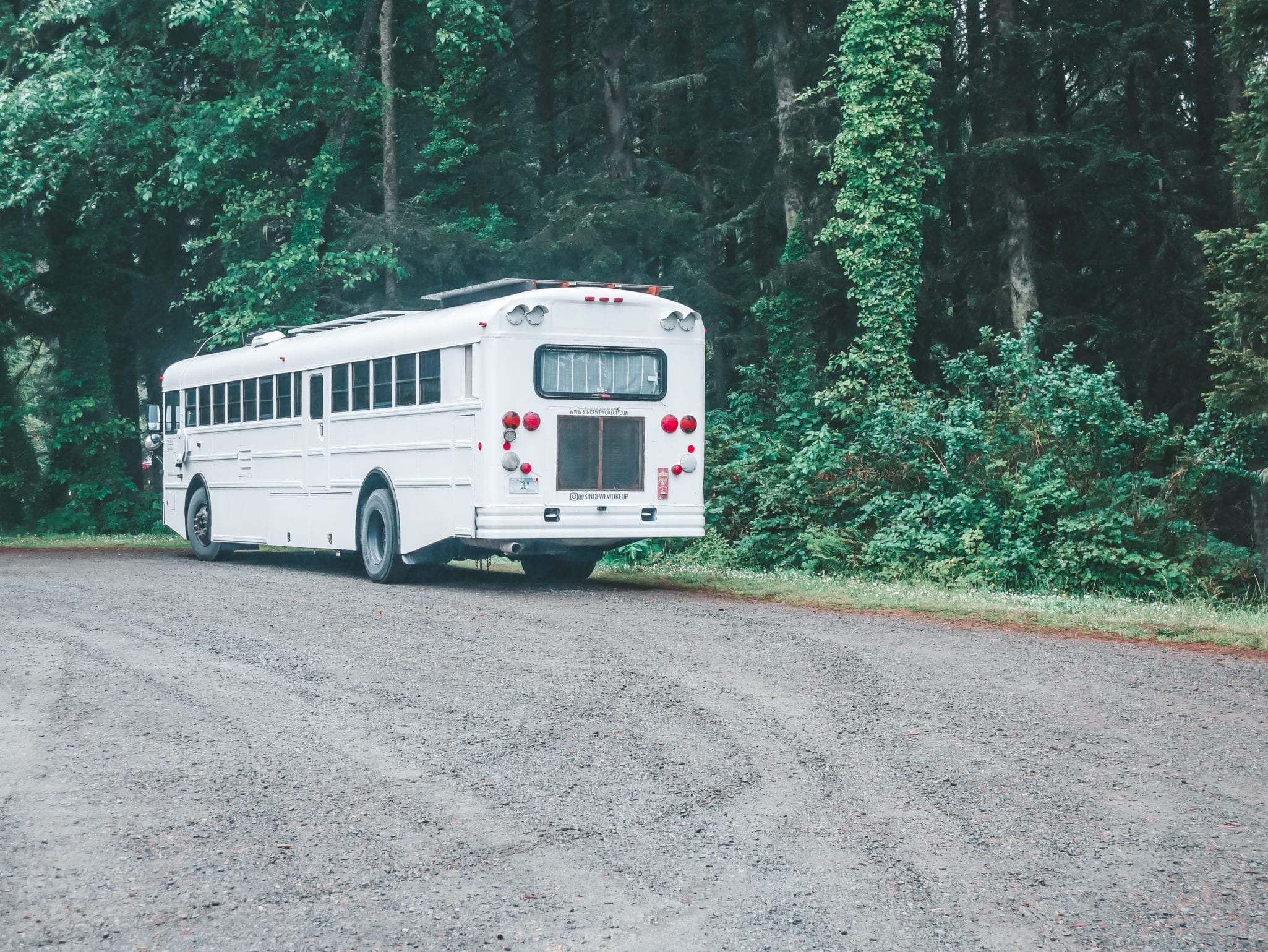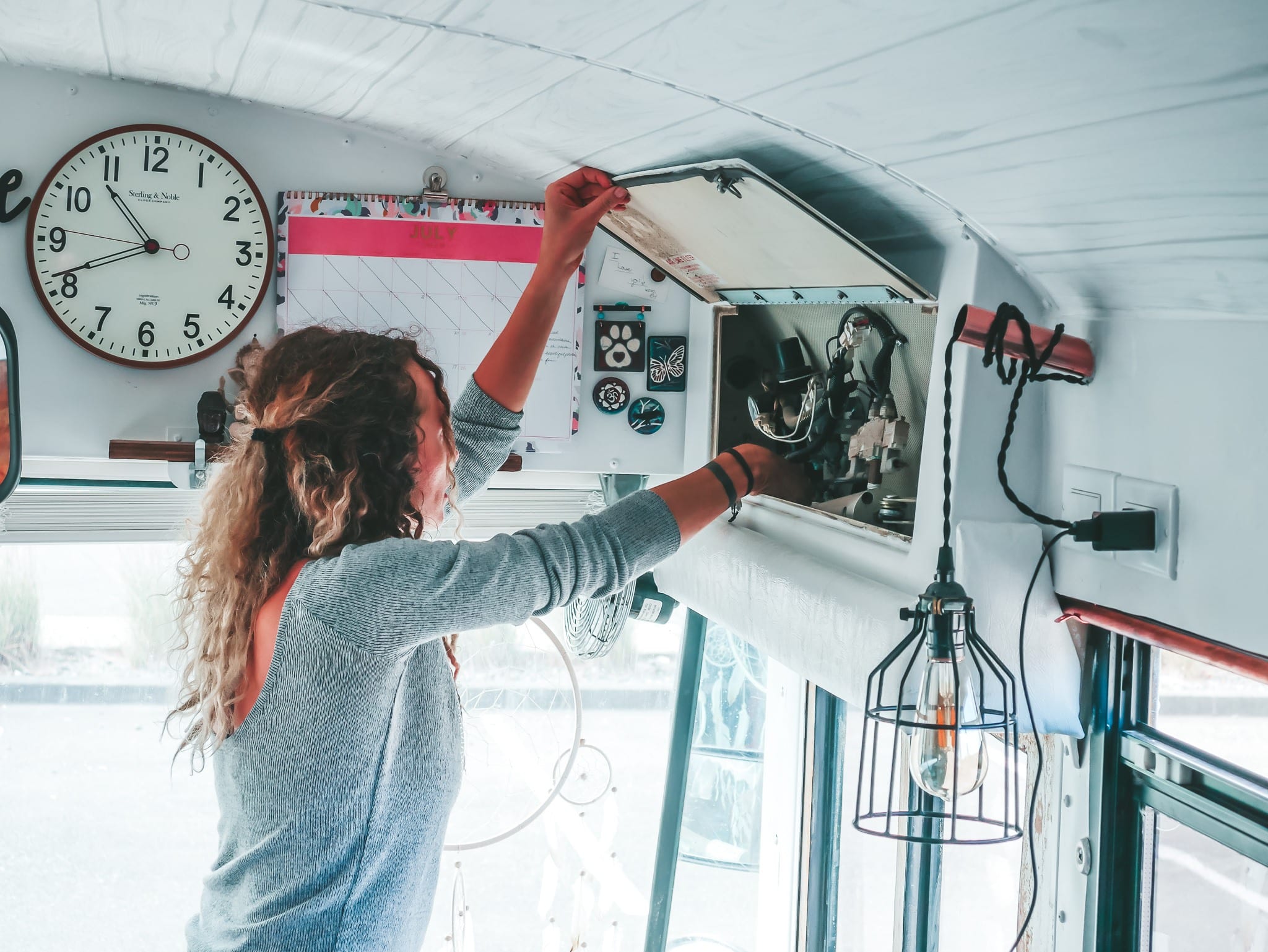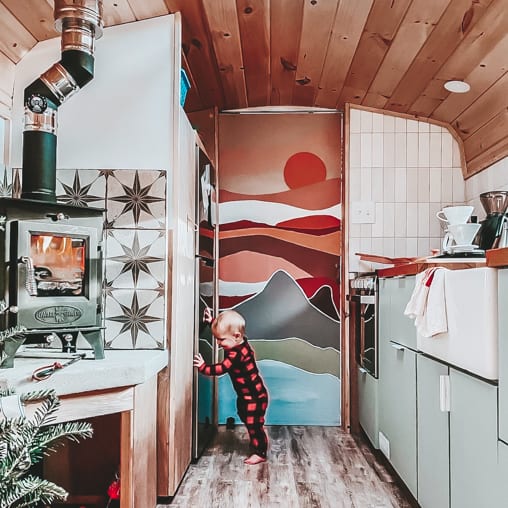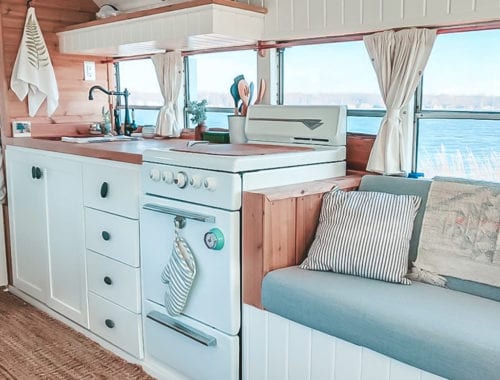The Downsides of Living in a School Bus
Social media can make bus life look absolutely glamorous, but the truth is, there are downsides to living in a school bus.
In any situation, there will be pros and cons, and I feel it’s important to document the whole truth – not just the side you see on bright and shiny Instagram.
Today we’re taking you on a journey through the not-so-fantastic parts of bus life {to be closely followed by a post of what we love, because there’s way more of that} and what we wish we would have known before we found ourselves driving a school bus home.
Keep reading to learn more about the downsides of living in a school bus.
PARKING AND DRIVING CAN BE A NIGHTMARE AT TIMES
Perhaps in a smaller bus or van, we wouldn’t encounter this as much, but parking has been a real B at times.
Oliver is forty feet of twisted steel and travel appeal. He doesn’t blend into a crowd or manage tight turns and narrow lanes without a LOT of maneuvering.

This means that unless you plan on spending all your time at RV parks, where parking spaces and roads are built for large rigs, you will inevitably find yourself dealing with driving and parking conditions that aren’t ideal for such a massive rig.
I have had every last ounce of my sanity tested trying to find a parking spot big enough or manage narrow city streets and turns with massive amounts of traffic behind me.
Finding parking for extended periods outside of RV parks, if you don’t own land to park on, is another challenge. Boondocking out in the wild is our favorite, but needing to have WiFi service for work and having to refill water means we have to balance that with other parking options closer to cities.
Takeaway: If you want to live in a school bus, realize that it isn’t all breezy travel days with the windows down and speakers blaring out road tunes. There will be moments of sheer anxiety and frustration trying to find a parking space, making right turns that defy the laws of physics while a line of traffic waits for you, and times where you simply accept a shoulder on a highway as a good night’s place to rest because you can’t stomach driving any further.
LOTS OF MAINTENANCE IS REQUIRED
You have basically built your home in an earthquake zone.
There will be roads that shake every bone in your body along with all your possessions. People will slam suddenly on their brakes, and you will be forced to follow suit, sending everything that isn’t nailed down sliding around.
Your cleverly constructed home is moved again and again, meaning even the best construction will start to show wear and tear over time as it creaks its way over thousands of miles.
Add to the equation that you’ve also built your home on a vehicle that requires its own maintenance and repairs. Batteries and tires that need to be replaced, oil and fluid and belts that have to be changed out, and random minor mishaps will crop up as you travel.

Before we take off, whether it’s the first day of a new big trip or every morning during those trips, there is a necessary walkthrough to make sure everything is ready to go.
At the end of every trip, there’s always an inevitable list of small repairs to be made.
There’s also regular maintenance of living, like a composting toilet that needs the liquids emptied every other day or so {solids about every month}. Even regular chores like taking the garbage out become a little harder when you don’t own a home with garbage trucks coming by once a week and have to scout your own waste disposal.
Laundry is another aspect to consider. We actually have a washer/dryer unit, but we can only use it when hooked up to shore power. When we travel, this adds stopping at a laundry facility to our chores from time to time.
We found we quickly adapted to these new chores, and they’re worth the extra “hassle”, but it’s worth mentioning for those considering a skoolie build.
Takeaway: Your home moves, has an engine, and no permanent address or utility hookups. Things are going to shift around and move and break, and you will have to get used to new chores like emptying sewage manually.
YOUR RESOURCES NEED TO BE REFILLED REGULARLY
Boondocking is our favorite way to spend time. There’s nothing more awesome than finding a remote parking spot in a beautiful location and spending several weeks just being.
At some point, however, the necessities have to be refilled.
We travel with 80 gallons of water and 40 gallons of propane. Our water lasts anywhere from one to three weeks, depending on how conservative we are. Propane holds us from two weeks to four.
When we’re in town, this is never an issue. A quick hookup at a friend’s or parent’s house for water and a trip down the street to the gas station secures our propane.
Propane generally isn’t an issue when we travel, but finding water has sometimes been a challenge.
On one particular trip, we realized our tanks were getting closer to empty than we generally allow. We couldn’t find a single water or propane hookup in the last little city we would be in before hitting a huge stretch of the open road and boondocking.
In that case, we backtracked up the road into a bigger town and found what we needed before continuing on.
Takeaway: A school bus doesn’t have utility hookups – meaning at some point you will forget to check the propane and run out of gas midway through cooking a meal or lose hot water midway through a shower. There will also be times while traveling when it won’t be convenient to refill these, and you’ll be forced to go out of your way to make it happen.
NO MATTER HOW NICE THE BUS IS, YOU WILL FIGHT PREJUDICE SOMETIMES
This is one of the downsides of living in a school bus I wish I would have known.
I’ve learned to say, “We built a tiny home out of a school bus” instead of saying, “We live in a school bus”.
The first gets greeted with, “Oh, that’s so neat”, followed by genuine interest and smiles; the second with, “Ohhhh, that’s interesting” as their face locks into a polite smile.
The thing is, a certain demographic of people are going to see you going against the societal norm as odd and weird and assume you’re a stoned-out hippie living in a van down by the river, forced to make a vehicle your home because you couldn’t handle being a productive member of society.
Others will applaud your choice to buck the social mold and follow your dreams of travel and freedom.
We parked at my parents’ house in-between trips, for instance, and their neighbor called us into the county code enforcement. Luckily we weren’t breaking any covenants {because we weren’t living there full-time}, but he made sure to tell my dad that we were driving property values down.
We’ve had skoolie friends on Instagram who had their buses spray painted because people were displeased they’d parked somewhere, even when they had permission to do so from the responsible party.
Takeaway: Realize that not everyone will see your life choices as a responsible or interesting way to live. You will be asked to move or leave at some point, or called into code enforcement, or met with a glazed-over look by someone who can’t imagine giving up their three-story for 200 square feet {even if it means nine-hour days at the office instead of absolute freedom}.
TRAVELING CAN BECOME OVERWHELMING IF NOT BALANCED
We learned quickly that while constant travel sounds cool, it’s actually incredibly tedious if done wrong.
Waking up with a new view every morning? Super cool.
Driving hours every single day, with no downtime to enjoy those views, or have simple routines that keep you feeling sane? Not super cool.

Every time we move the bus, there’s a short getting-ready routine to put the bus into travel mode. Every time we stop for the night, it’s reversed as the bus goes back into normal living mode.
We prefer to have no agenda and find a place that we can park and enjoy for several days at a time as opposed to having a strict timetable that keeps up traveling hours every single day.
Our general rule is to travel no farther than two hours a day while on bigger trips, stopping where we feel like it {even if it’s only 15 minutes away from the last spot}, exploring and enjoying an area entirely before moving on. This allows us to have simple routines and keep somewhat of a schedule while constantly changing scenery and allowing our wanderlust to be appeased.
Takeaway: Driving hours every day chasing a new horizon get tedious. If you want your travel lifestyle to be sustainable, finding small routines and balancing driving with living and exploring is a must.
THE DOWNSIDES OF LIVING IN A SCHOOL BUS
There are a few downsides to living in a school bus, but the same holds true for every life decision. There will always be drawbacks.
With that being said – I wouldn’t trade this life for another.
I built my home with my hands, a dream on paper made real. I get to choose what every day looks like, what I’m waking up to. If I decide to, I can drive away on a whim to the woods and disappear into the quiet stillness until I’m ready to reappear into the world {or until we need water!}.
This lifestyle has given me new friends, experiences, and perspectives that I never would have had in my stick-built home.
Are you curious how we went from a “normal” life with a three-story and brick-and-mortar business to an entirely nomadic life? Check out our post detailing everything from the process to the financials of the transition!






